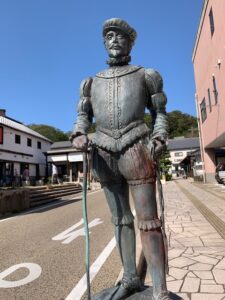Hirado is a little gem. The small town of 31,000 has a port overlooked by a castle, and in the past had important continental connections. Tucked into Kyushu’s northwest corner, it is mostly neglected by tourists because of its remoteness.
Historically, Hirado played a key role in the early seventeenth century, when the Dutch and the English set up ‘factories’ (an old fashioned term for trading post). The Dutch were first in 1609, and they stayed until forced to relocate in 1640. They were more adept at business than the English, who arrived in 1613 and barely lasted ten years.
(The following is an excerpt from a longer chapter in the forthcoming publication, Japan by Train (Stone Bridge Press).
********************

A notice at the information office offered a half-day guided tour, which I joined along with a party of three middle-aged Japanese. We headed first to the nearby promontory on which the Dutch trading post stands. The guide pointed out the deep channel where ocean-going ships from Europe would anchor, before transferring their goods to small boats that ferried them to the stone steps where we stood.
Before us was an island with an attractive Benten shrine, a fine example for the Europeans of the sanctification of nature. The deity is the only female among the Seven Lucky Gods, and as muse of the arts she is closely associated with water and the subconscious. The Dutch traders would have seen her every single day, but only at a distance. ‘It was taboo to tread on Benten’s sacred soil,’ our guide told us. ‘Still today we citizens of Hirado keep that tradition.’
‘Please look over there,’ he continued, pointing at the castle. ‘The original belonged to the Matsuura clan, but in 1613 they destroyed it. It is very unique, I think. The reason is because they fought against the Tokugawa at Sekigahara, so they were not trusted. They worried about that. So they wanted to show they were not a threat. It was very clever, because they could keep their power.’
Next stop was the solid-looking Dutch warehouse, where some startling statistics were thrown at us. The building had eighteen wooden beams and massive square pillars half a meter wide. Altogether there were 21,000 interlocking stone blocks. Yes, 21,000! The result was a huge, Dutch-style building, finished off with a Japanese tiled roof.
The original building took eight months to complete; the reconstruction took two years. A concern to be as authentic as possible meant timber had to be imported from Canada, because there were no longer trees of sufficient thickness in Japan – pause for thought in a country that is 67% forested.
‘What happened to the original building?’ asked one of the Japanese. ‘Ah, that is interesting,’ said the guide, looking at his watch. We were behind schedule. ‘To make a long story short, the Dutch wrote the date of the building above the entrance, and when the Tokugawa heard of that, they demanded the whole building be torn down.’
He left a dramatic pause, and asked if we could guess why. I knew the answer all too well, because I had used it in a book I wrote to illustrate how paranoid the Tokugawa were about the European religion. So after a decent pause, I piped up with, ‘They wrote 1639, which was the date according to the Christian calendar. Anything to do with Christianity was banned.’ ‘Sugoi,’ (Amazing) said one of the Japanese. ‘He knows our history better than we do,’ said another, ‘We have to study harder.’
Inside the building was an overview of Dutch-Japanese trade, and on display were two gorgeous boxes lacquered in black and decorated with flowers and birds in mother of pearl. Such goods sold well in Europe. There was too a beautiful miniature of the wonderfully multi-sail Liefde, the first Dutch ship to reach Japan in 1600. The two main masts were nearly as high as the ship was long. What a giddy prospect to have to climb them in stormy seas!



Leave a Reply